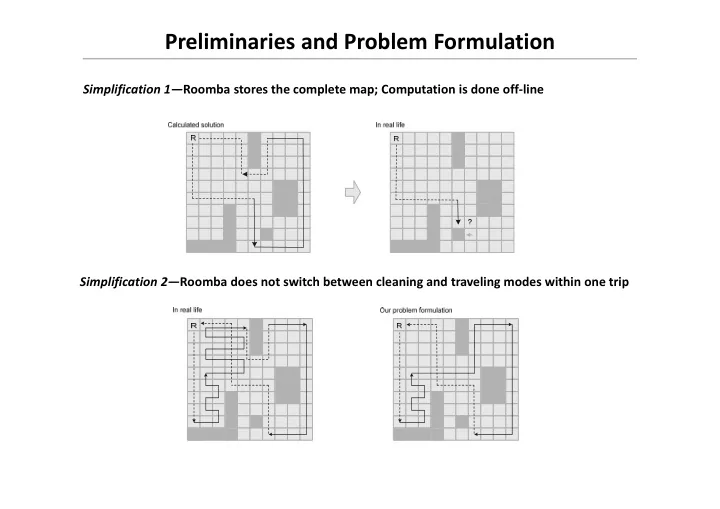

Preliminaries and Problem Formulation Simplification 1— Roomba stores the complete map; Computation is done off-line Simplification 2— Roomba does not switch between cleaning and traveling modes within one trip
Algorithm Design Key idea: Design a brute-force algorithm that checks all feasible paths when battery constraint allows. Actions: Step 1: Loop through all possible starting points. Step 2: For each, try moving all possible directions. Base Case 1: Dead end Base Case 1: Dead end Base Case 2: Battery exhausted. Can’t afford cleaning and moving back from the current vertex.
Pseudo-code 1 Graph input ; 2 BooleanMatrix matrix ; 3 int maxGoodness ; 4 GraphSolution output ; 5 Stack<Vertex> sequence ; Helper methods that are needed: J ADE -M ESH -O UTER L OOP ( Graph graphInput ) input ← graphInput ; 6 matrix ← initialize as the size of graphInput and populate with false; 7 maxGoodness ← the minimum integer; 8 output ← null; CAPACITY T O B ASE ( int x’, int y’ ) 9 sequence ← initialize as a new object; 1 return distance( input. base. x , input. base. y, x’, y’ ); 10 for int i ← 0 to i ← graphInput. width; i++ { 11 for int j ← 0 to j ← graphInput. height; j++ { IS B ATTERY E XHAUSTED ( int x, int y, int capacity ) 12 13 J ADE -MESH-R ECURSION ( i, j, 0, 2 if capacityToBase( x, y ) + input. consumption( x, y ) + 1 > graphInput. capacity – capacityToBase( i,j )); capacity { 14 } 3 return true ; 15 } 4 4 } } return output; 16 5 return false ; J ADE -M ESH -R ECURSION ( int x, int y, int goodness, int capacity ) IS B LOCKED ( int x, int y ) 17 if isBlocked( x, y ) = true or isBatteryExhausted( x, y, capacity ) = true { 6 if x < 0 or x <= matrix. width 18 If output = null or goodness > maxGoodness { or y < 0 or y >= matrix. height { maxGoodness ← goodness; 19 output ← new GraphSolution( sequence, goodness ); 7 return true ; 20 8 21 } } 22 return ; 9 if x = input. base. x and y = input. base. y { 23 } 10 return true ; 24 sequence. push ( new Vertex( x, y ) ); 11 } 25 matrix. mark( x, y ); 12 return matrix. isMarked( x, y ) ; int newGoodness ← goodness + input. priority( x, y ); 26 int newCapacity ← capacity – input. comsumption( x, y ) – 1; 27 28 J ADE -MESH-R ECURSION ( x – 1 , y, newGoodness, newCapacity ); 29 J ADE -MESH-R ECURSION ( x + 1 , y, newGoodness, newCapacity ); 30 J ADE -MESH-R ECURSION ( x, y – 1 , newGoodness, newCapacity ); 31 J ADE -MESH-R ECURSION ( x, y + 1 , newGoodness, newCapacity ); 32 sequence. pop(); 33 matrix. unmark( x, y );
Simplified Example All candidate solution is battery allows: ��������� ����� ����� ����� Path c Consumption p Summation ����� D, C, B 9 10 ����� ����� ����� ����� B, C, D 9 10 C, B 7 8 ��������� ��������� ��������� ����������� ����������� ����������� B, C 7 8 ������������ ������������ ������������ D, C 8 7 ��������� ��������� �������� ��������� ����� ����� ����� ����� ����� ����� ����� ����� C, D 8 7 ����� ����� ����� ����� �������� �������� C 6 5 ����� ����� ����� ����� ����� ����� ����� ����� ����� ����� B 4 3 ����� ����� D 5 2 ��������� �� ��������� �� ��������� �� �����"��� �� ����������! ����������" ����������" ����������! ����������"� ����������!� ����������!� ����������"� ��������� ��������� ��������� ��������� �������� ����� ����� ����� ����� ����� ����� ����� ����� ����� ����� ����� ����� ����� ����� ����� ����� Final solutions for specific battery input: �������� �������� �������� ����� ����� ����� ����� ����� ����� ����� ����� ����� ����� ����� ����� ����� ����� ����� ����� Battery Capacity Final Solution C >= 9 D, C, B or B, C, D �����!��� �� �� �����#��� �� �� ����������# ����������# ������������� ������������� C = 7, 8 B, C or C, B ��������� ��������� �������� ����� ����� ����� ����� ����� ����� ����� ����� C = 6 C �������� ����� ����� ����� ����� ����� ����� ����� ����� C = 4, 5 B C < 4 null
Complexity Analysis Time Complexity Jade-Mesh-OuterLoop Method: Jade-Mesh-Recursion Method: Overall Time Complexity: Overall Time Complexity: Space Complexity
Improvement Attempt The worst case scenario: Battery capacity is sufficient and does not act like a constraint in the problem. The worst case of a particular map: Can be addressed as a variant of the Longest Path Problem—a know NP-Complete . Conclusion: It is unlikely for us to find a polynomial algorithm for this problem set.
Recommend
More recommend